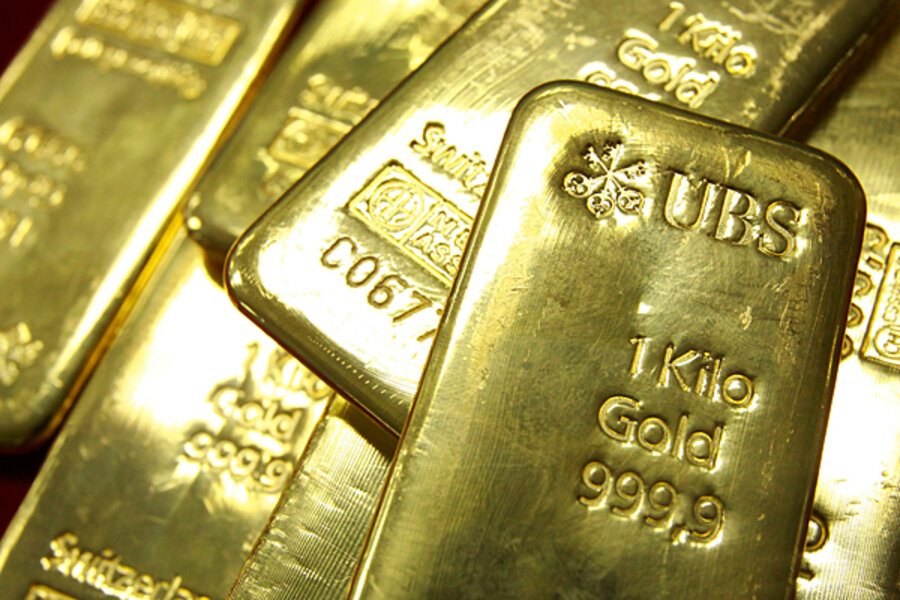$1,506 an ounce: What's behind the rush on gold?
Loading...
| New York
Since last April, gold has been the shiniest of investments, rising almost 32 percent.
More recently, bullion is up about 5 percent in the last three months. And, on Thursday, it hit a record $1,506 per ounce, up $7.70.
What’s behind the run-up in the metal?
To buyers of gold, it’s a good hedge against inflation – something they are worried about because of the huge US budget deficits and the Federal Reserve's accommodative monetary policy that has kept interest rates low. But, people who are anti-gold, argue there is no sign of inflation in the economic statistics and the Fed will push up rates once it perceives inflation becoming a problem.
In the past week, gold has benefited from the announcement by Standard & Poor’s that it was downgrading the outlook for US government debt because of all the political uncertainty over resolving the US deficit issue. But, even before that move, gold has been rising at the same time as the US dollar has been sinking.
“Investors are concerned about the long-term purchasing power of the US dollar,” says Axel Merk, president of Merk Investments, which owns some gold and manages $650 million from Palo Alto, California. “The fear is the US budget is not on a sustainable path and our policymakers are not taking it seriously enough.”
The rising price, combined with concerns about inflation, is prompting some nontraditional buyers to invest. For example, John Paulson, a hedge fund manager who made billions in the collapse of the financial markets, decided to buy gold last year, writes Gregory Zuckerman, the author of the Greatest Trade Ever, the description of Mr. Paulson’s winning strategy during the housing crisis.
In addition, some mutual funds are now starting to add gold to their investments. And, it has become easier to buy gold-related products with some new financial products such as Exchange Traded Funds, which are traded on the exchanges but buy gold bars and let investors own a share of the ownership without worrying about vaults and insurance.
“Investors are flocking to gold,” says Mr. Merk.
In the past, many mainstream economists were doubtful about gold as an investment. They reasoned that gold did not pay any interest and was expensive to store. However, that view is starting to change.
'Not in bubble territory ... yet'
In a report on Wednesday, senior economist Scott Anderson of Wells Fargo Securities writes that the fundamentals “justify the high price of gold.” The headline to his research: “Gold not in bubble territory … yet.”
Although inflation is not a major economic worry yet, Mr. Anderson thinks it’s “creeping higher and higher.” In addition, he’s concerned that reducing the soaring US government debt and deficit may entail “significant sacrifices that many Americans may be loathe to endure.”
According to Mr. Zuckerman’s book, Paulson decided his next money-making enterprise was to bet against the US dollar. According to the book, he calculated the supply of dollars had expanded by 120 percent over several months following efforts to prevent an economic depression.
“With all this spending, we’re going to have massive inflation,” said Paulson. “What’s the only asset that will hold value? It’s got to be gold.”
To Merk, the falling dollar is part of Federal Reserve Chairman Ben Bernanke’s strategy. “He [Bernanke] does not think a weaker dollar is inflationary.”
However, some other economists are not so certain gold is the best investment.
“Gold is the investment for people who have lost hope in everything else and are not thinking about what they are investing in,” says Robert Brusca of Fact & Opinion Economics in New York.
He argues that if the Federal Reserve sees inflation picking up, it will raise interest rates. “Higher interest rates are like antimatter for gold,” he says since gold pays no interest.
Optimism Congress will act
Mr. Brusca is also optimistic that Congress will act to start to reduce the deficits in the future. “The odds are they will get something done,” he says. “The purchase of gold is in some sense a play against the financial probity of the United States.”
Gold is still not at its record high value, which would be $1,945 per ounce in today's dollars, a level set in January 1980. After that it fell to as low as $437 an ounce by 2005, also in today's dollars.
Merk says investors need to be aware gold can be volatile.
“The correction in gold can be rather severe,” he warns.
Monitor intern Geoff Johnson contributed to this report.





